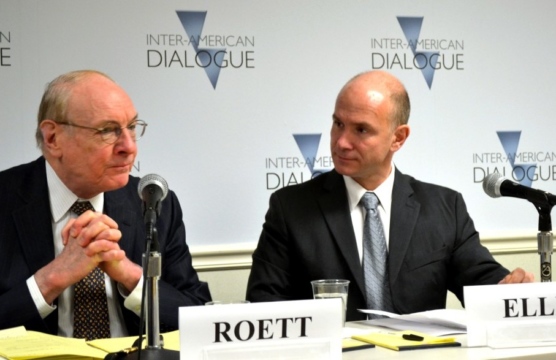Covid-19 has accelerated digitalization all over the world. Things that chief technology officers had planned to be implemented in years had to be put in place in weeks, or even days. E-commerce, e-payments, remote work, video calls and streaming are now essential parts of our social and productive lives. Indeed, some in-person activities are gradually coming back, but a significant part of our day-to-day activities will likely become digital forever.
Latin America has been no exception to this phenomenon, and digitization “out of necessity” has become the norm since mid-March 2020, with Internet traffic increasing more than 40 percent overnight. Among the many factors that facilitated this transition is a solid and robust telecommunications infrastructure in the region, which was built with investments by operators over the past 30 years or so.
Now that vaccination has finally taken off in Latin America, despite the challenges that the new variants have created, we have the chance to look a bit further ahead and assess how we are doing.
Though we remain optimistic about the future state of digitalization, given that the recovery will be digital or there will be no recovery, we feel there is much more to do. As enablers of connectivity, we see five “inconvenient truths” blocking our way toward a digital Latin America 4.0:
- Telecommunications investment has been falling in per capita terms since 2010 in Latin America. According to Katz and Jung (2021), Latin America invested $43 per inhabitant in 2020, down from $46 in 2019. It also fell in 2020, with the notable exceptions of Brazil and Panama, where the governments have taken some bold approaches to spur investment and have made efforts to digitize all the public administrations and companies where they have ownership. Indeed, some operators have accelerated investment. But on aggregate, the gap between Latin America and the United States (where per capita investment is 7 times higher), Europe (3 times higher) or Asia (2 times higher) is only increasing. Expensive spectrum, excessive regulatory fees and burdensome and outdated local regulations are diverting key resources from where they would be more effective: closing the digital divide in remote and rural areas, and upgrading existing infrastructure and services to help the region to benefit from the digital revolution.
- There are really two issues to address that are highly interrelated: ensuring competitive markets and encouraging permanent cash flow from the private sector in these markets. Indeed, in Latin America, investment in telecommunications depends almost exclusively on the flow of private investment, which is very different from other infrastructure sectors such as energy, transportation or water. This means that the private sector will have to pay the cost of closing the digital divide, and for this to happen the business cases and financial incentives have to be clear for investors in New York or London to support these investments. The IDB estimates that in Latin America $18.7 billion is needed to close the digital divide in mobile and another $50 billion for fixed. Therefore, we must begin to redefine certain elements of our current ecosystem so that more efficiencies can be created and investment can flourish.
- Many of the digital and telecommunication policies we see are well-intended but fail to include necessary incentives to promote and support investments. Again, we should celebrate the flexibility that many Latin American governments showed during the pandemic, and the renewed focus on expanding connectivity that emerged. But, as previously stated, most of that money is expected to come from the private sector. The economics are very clear: with smart and flexible regulations by forward-looking institutions, investment increases by as much as 64 percent, according to Jung and Melguizo (2020). The region risks falling victim to the rhetoric of closing the digital divide but never actually creating the policies or investment incentives to make this a reality. From price controls to unaffordable spectrum, Latin America continues to lag behind on creating smart policy for better connectivity.
- Competition regulation has blind spots. In the last 15 years most audiovisual OTTs—and many of the popular apps such as Instagram, Twitter, Uber, Cabify, Lyft, Rappi and Glovo–were launched. So how we communicate, move, buy and inform ourselves has changed. Rules and institutions should adapt to new times to ensure a level playing field and healthy competition in today’s environment. Telecommunications markets are evolving, and we must rethink old and outdated paradigms. Market structure is low-hanging fruit in that regard—in most of our markets in Latin America, there is really only space today for two or three operators. Margins and ARPUs are under severe pressure, which will lead to financing problems in the sector in the long-term if market structure is not adequately addressed. Sufficient gains cannot be extracted from these smaller countries if there are more than three players—the pie is simply not big enough and investment and the quality of services provided suffer as a result.
- Telecoms is the unsung and little understood hero of the digital ecosystem–the less sexy, less flashy “dumb-pipes” that provide the backbone infrastructure, without which there would be no fourth industrial revolution in technology. The reality is that our sector’s investments are the foundational building blocks of the region’s digital infrastructure. The future success of both our sector and our countries are intertwined–their growth depends on our digital highways and vice versa. Every company today requires high-speed digital highways on which to run their products and systems to create new services and innovations for the world. Telecoms companies build and operate such infrastructure and have had to increase network capacities during the pandemic.
Still, we are optimistic Latin America can and will fully embrace #DigitalTransformation. Our telecommunications infrastructure has passed a formidable stress test with high marks since March of 2020. Now is the time to take further steps, based on smart digital regulation (neutral, global and innovative), and public-private partnerships (including increasing the capital of development banks). We call for a comprehensive regulatory revamp to prepare for the challenges of the coming 20 years, not just for the next few quarters. Data protection and privacy, IP protection, anti-piracy efforts, cheaper access to and efficient management of spectrum, and tax reform are key areas.
The current mobilization of money, politics and ideas is unprecedented. And so is the opportunity that the situation has created for Latin America and the Caribbean. Carpe Diem!
Karim Lesina is executive vice president and chief external affairs officer at Millicom
Angel Melguizo is vice president of external and regulatory affairs at VRIO Latin America
The opinions expressed in this post are those of the authors. They do not purport to reflect the opinions or views of their employers, the Inter-American Dialogue or the Latin America Advisor publications.
 The daily Latin America Advisor features comments from global leaders in politics, economics and business. It is available to members of the Dialogue’s Corporate Program and others by subscription.
The daily Latin America Advisor features comments from global leaders in politics, economics and business. It is available to members of the Dialogue’s Corporate Program and others by subscription.

 The daily Latin America Advisor features comments from global leaders in politics, economics and business. It is available to members of the Dialogue’s Corporate Program and others by subscription.
The daily Latin America Advisor features comments from global leaders in politics, economics and business. It is available to members of the Dialogue’s Corporate Program and others by subscription.